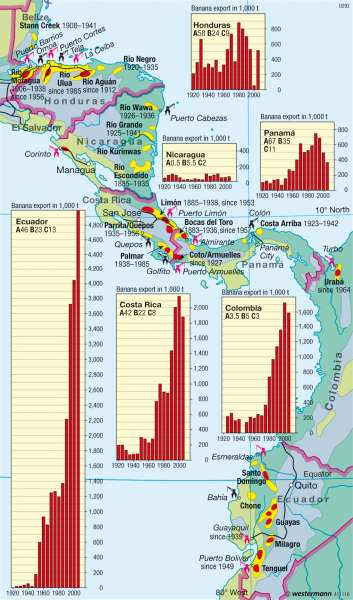Central America — Banana cultivation
The Americas - Agriculture
978-3-14-100790-9 | Page 129 | Ill. 3

Information
Commercial banana cultivation is limited to the rainy, hot lowlands of the tropics, such is the climate of Puerto Limon in Costa Rica. Uniformly high temperatures of around 28 °C , a monthly rainfall of up to 160—180 millimetres and deep, mineral-rich, well drained soil are required for good shrub growth. Increased risks arise from wind damage and fungal attack. Less favourable locations have been abandoned during the course of the 20th Century.Origin and characteristics of the cultivation
The foundations for banana production in plantations were the hinterlands of Puerto Limón, which developed after 1883 in large scale acreages and in the vicinity of a new railway line. The increased cultivation on the Caribbean coast continued mainly in the favoured port areas. The shift to the interior came about with the expansion of the railway. In the 1920's and 1930's, increased problems caused by plant diseases and overuse by monoculture occurred in the old production areas. This led to major shifts towards the Pacific coasts of Panama, Costa Rica and Guatemala. Crops such as cocoa, citrus fruits, palm oil, tropical wood and rubber trees have been planted in the derelict sites, areas which were occupied by small farmers or abandoned and re-forested.
The commercial cultivation is now concentrated on the hinterland on the exit ports. Due to high capital requirements for infrastructure, development and ongoing operations, as well as the specific associated risks, banana production is usually conducted by large companies. At times, the United Fruit Company, founded in 1899, had monopolised product transportation and marketing of the banana. Even today, multinational corporations dominate the production in Central America, but are mostly carried out by national partners. Also the marketing of the multinational companies is perceived as one-sided. The attempts of a nationalisation of production and distribution have largely failed, which is why foreign companies have regained control. Of the proceeds from the banana industry, only a small portion remains in the originating country - although the smaller states of Central America have been given the term "naturalised banana republics" due to the formative influence of the plantation economy.
Bananas for the world market
The main banana importers are the EU and the USA. Until 1993, the EU countries had different rules on banana imports, which made it necessary for the creation of an amicable internal market in Europe. After heated discussions and difficult negotiations, the EU bodies decided in favour of a complicated system of balances, reference volumes, quotas, licenses, tariffs and subsidies. The estimated consumption of 3.7 million tonnes is split among three main groups of producers, with overseas territories and former colonies of EU countries strongly preferred (EU bananas).
The reduced proportion of formerly dominant suppliers, especially from Latin America, and the limitation of the import quota to 66.5 percent, resulted in an importer redistribution, which was then taken up by stakeholders in a flood of serious lawsuits.
Due to the expected prior decision in favour of free markets and rapid integration of Eastern European countries into the global economy, the main producing countries like Costa Rica, Colombia and Panama, had initiated timely programmes to increase production. With this, the multinational corporations shifted once more to the cultivation of fruits. The columns in the graphs show the rapid increase in production, which has existed over the past two decades, especially in Ecuador, Costa Rica and Colombia.
Because of the restrictive EU rules, producing countries not covered by pricing quotas, offered low prices to other markets and were forced to set aside land. World prices fell sharply, while market prices in the EU increased because of shortages. The dispute continues on and its main players are the United States — as the headquarters of many multinational corporations — and the EU. The WTO decided in favour of the United States in 1999, that the EU trade regime had contravened the WTO principles of free trade. Hundreds of millions of U.S. Dollars in punitive tariffs were imposed against the EU.
Aside from the developments on the world market, the strongest export decline in Honduras was just before the millennium. The main cause was Hurricane Mitch, one of the worst tropical cyclones in recent history, which claimed approximately 10,000 lives, destroyed large parts of the infrastructure and devastated plantations in Honduras and Nicaragua.
H. Nuhn; Ü: C. Fleming




